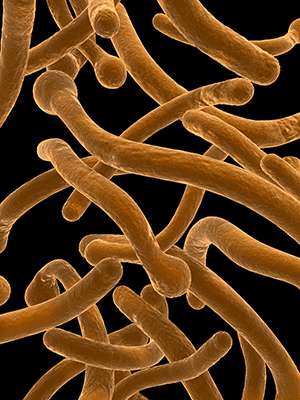Through a process known as concerted chromosome loss, Candida albicans cells (pictured) containing two sets of chromosomes can form mating-competent and viable cells that contain a single set of chromosomes. Credit: Hemera/Thinkstock
Scientists long believed that the fungal pathogen Candida albicans was incapable of producing haploid cells—which contain only one copy of each chromosome, analagous to eggs and sperm—for mating. Mixing of genes in sexual reproduction helps generate the diversity that is the raw material for evolution, and C. albicans' inability to reproduce sexually appeared to give it a disadvantage. An international research team, including Yue Wang at the A*STAR Institute of Molecular and Cell Biology in Singapore, has now found viable haploid strains of C. albicans. The finding illuminates C. albicans' evolution and pathogenicity.
The team's discovery of the haploids was serendipitous. Team members in Ching-Hua Su's laboratory at the Taipei Medical University, Taiwan, studying C. albicans strains growing in media containing an antifungal drug, noticed a strain with half the usual amount of genetic material. Further analysis revealed that the strain lacked one of each of its eight chromosomes, indicating that it was in fact haploid.
Work in Wang's laboratory at A*STAR and in Judith Berman's laboratory at the University of Minnesota in the United States, revealed many strains of both in vitro and in vivo haploids. Not only could the haploids form all of the same developmental stages as their diploid counterparts, they formed cells that could mate.
The haploid cells were less fit than diploid cells: they grew slowly and were avirulent in mice. They were also ephemeral as after a short time in culture, they duplicated their own genetic material to become diploid. These so-called auto-diploids were also less virulent than wild-type cells. When two haploids mated, however, they produced diploid cells with a mixed genetic background and increased virulence and growth.
"Generation of haploid cells through random loss of chromosomes followed by mating between haploid cells of opposite sex generates genetic variation, which is important for adaptation and evolution of this fungus," explains Wang.
The haploids will serve as an invaluable research tool in genetic and drug-discovery studies. Studying gene function in a diploid organism requires deleting both copies of a gene, which is technically very difficult, Wang notes. Researchers will now be able to delete genes in a single step.
Wang's team painstakingly screened thousands of isolates to identify several stable haploid strains. From these, they constructed a set of strains that will make genetic manipulation rapid and effective. "Preliminary screens of a small number of mutants have already identified several new genes important for virulence, promising more discoveries in the near future," says Wang.
More information: Hickman, M. A., et al. The 'obligate diploid' Candida albicans forms mating-competent haploids. Nature 494, 55–59 (2013). www.nature.com/nature/journal/ … abs/nature11865.html
Journal information: Nature



















